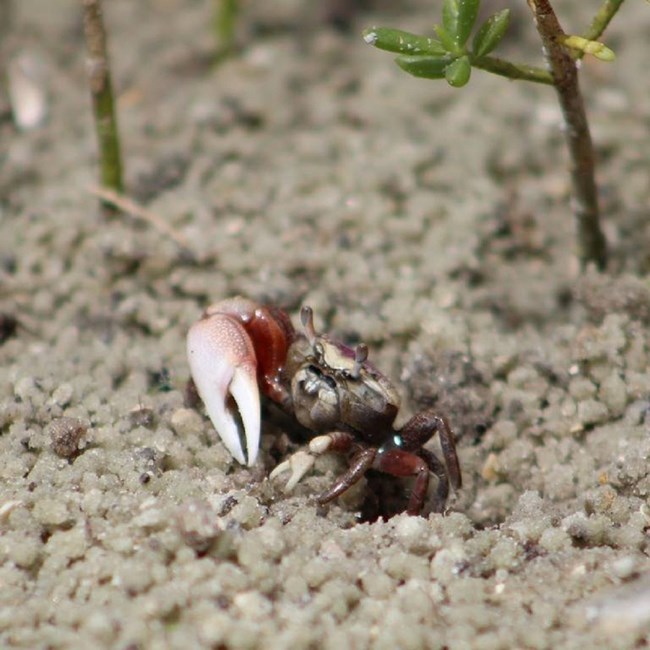
The most distinguishing feature of these crabs, besides their propensity to mass together in huge numbers, is the one overgrown claw present on each male. (This also accounts for their common name, since to someone it must have looked as if they were carrying around large fiddles, or perhaps built up the muscles in one of their arms on the account of way too much fiddling!) This one claw can comprise up to one-half the body weight of each male crab. One of the main uses of the claw is to intimidate other males (guys being guys). Usually this only amounts to one crab displaying his claw to others in his area, but sometimes fighting can ensue. If a claw happens to become detached in the struggle, no worries. The crab’s other smaller claw will grow large to replace the large one that was lost, while a new smaller claw will grow where the large one had been. Amazing! The small claw is the one that the male crab eats with. Technically, these claws are front legs that end in pincers, and hence are called chelipeds. The other four pairs of legs on each crab do not have pincers and are used instead for locomotion. Something else is noticeable when walking amongst the fiddler crabs. Wherever they are there tend to be lots and lots of small little mud balls covering the surface of the mud flats. These are the direct result of the crabs’ feeding habits. The fiddlers take in a mouthful of mud and are able to separate out their food (algae and decaying plant and animal matter) and then spit out everything else that is inedible in one compact little mud ball. In essence, a fiddler crab spit ball! Besides the mud balls lining the surface of the mud flat in the fiddler crab colony, there are also many small holes in the ground. These are fiddler crab burrows. Each crab digs its own burrow, and uses the burrow to escape predators and the scorching sun. Hence a crab will never stray too far from its burrow. Even when high tides inundate the crab colony, the crabs retreat to their burrows and plug them up with mud, keeping them low (not high!) and dry. (Fiddler crabs possess both gills and lungs, and can breathe underwater if necessary.) Burrows are also where fiddlers hibernate during the winter season. A side effect of all this burrow digging is the aeration of the marsh soil, which help grasses like saltmarsh cordgrass to thrive. Actually, not every fiddler crab burrow is used for shelter. Males also dig special “mating burrows”. This activity happens during the hot summer season. When not defending his special burrow against other males, a male crab will try to entice a female crab to enter it by waving his large claw and racing between potentially interested females and his carefully excavated boudoir. If he gets a female to approach he will then enter the burrow and start drumming against its sides to create subtle vibrations. When a female finds these vibrations too much to resist she will enter the burrow herself and mate with the male occupant. The female will then carry her fertilized eggs close to her abdomen for two weeks before releasing them into the water where they will hatch out as larvae. By the end of the season a female will have released hundreds of eggs this way. (It pays for the fiddlers to be prodigious in their reproduction because they only live for three years at the most.) There are plenty of other creatures in the salt marsh who try their best to make sure the fiddler crabs do not live out their natural lifespan. These include fish, raccoons, birds, and blue crabs. Even though the fiddler crab’s exoskeleton, or carapace, is made of chitin (a nitrogen-containing polysaccharide polymer), which gives it a certain rigidity, it is not hard enough to ward off the larger predators of the marsh. The carapace does have the ability to change color somewhat, becoming darker during the day and paler at night. This characteristic most likely enables the cold-blooded crabs to absorb more infrared light during the day and boost their energy level. The fiddlers actually lose their shell one or two times per year in order to grow larger. They will produce a new and larger carapace to protect their body, but during this molting period they are even more sensitive to environmental contaminants like insecticides. So the next time you are strolling through the mud flats at the edge of a salt marsh, step carefully and take notice of the activity at your feet. If you are in a marsh fiddler crab colony you may be vastly outnumbered by a fascinating species of crustacean that is well worthy of your interest and respect. |
Last updated: January 15, 2022
